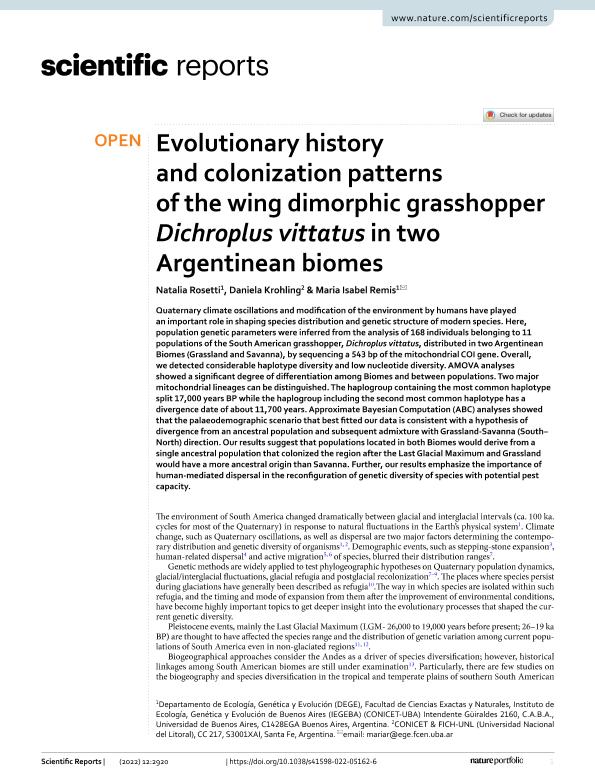Artículo
Evolutionary history and colonization patterns of the wing dimorphic grasshopper Dichroplus vittatus in two Argentinean biomes
Fecha de publicación:
12/2022
Editorial:
Nature Publishing Group
Revista:
Scientific Reports
ISSN:
2045-2322
Idioma:
Inglés
Tipo de recurso:
Artículo publicado
Clasificación temática:
Resumen
Quaternary climate oscillations and modification of the environment by humans have played an important role in shaping species distribution and genetic structure of modern species. Here, population genetic parameters were inferred from the analysis of 168 individuals belonging to 11 populations of the South American grasshopper, Dichroplus vittatus, distributed in two Argentinean Biomes (Grassland and Savanna), by sequencing a 543 bp of the mitochondrial COI gene. Overall, we detected considerable haplotype diversity and low nucleotide diversity. AMOVA analyses showed a significant degree of differentiation among Biomes and between populations. Two major mitochondrial lineages can be distinguished. The haplogroup containing the most common haplotype split 17,000 years BP while the haplogroup including the second most common haplotype has a divergence date of about 11,700 years. Approximate Bayesian Computation (ABC) analyses showed that the palaeodemographic scenario that best fitted our data is consistent with a hypothesis of divergence from an ancestral population and subsequent admixture with Grassland-Savanna (South–North) direction. Our results suggest that populations located in both Biomes would derive from a single ancestral population that colonized the region after the Last Glacial Maximum and Grassland would have a more ancestral origin than Savanna. Further, our results emphasize the importance of human-mediated dispersal in the reconfiguration of genetic diversity of species with potential pest capacity.
Archivos asociados
Licencia
Identificadores
Colecciones
Articulos(CCT - SANTA FE)
Articulos de CTRO.CIENTIFICO TECNOL.CONICET - SANTA FE
Articulos de CTRO.CIENTIFICO TECNOL.CONICET - SANTA FE
Articulos(IEGEBA)
Articulos de INSTITUTO DE ECOLOGIA, GENETICA Y EVOLUCION DE BS. AS
Articulos de INSTITUTO DE ECOLOGIA, GENETICA Y EVOLUCION DE BS. AS
Citación
Rosetti, Maria Eva Natalia; Krohling, Daniela Mariel Ines; Remis, Maria Isabel; Evolutionary history and colonization patterns of the wing dimorphic grasshopper Dichroplus vittatus in two Argentinean biomes; Nature Publishing Group; Scientific Reports; 12; 1; 12-2022; 1-18
Compartir
Altmétricas




